Excel导出
简介
Viedoc导出的Microsoft Excel Open XML格式,可使用Excel 2007及以后的版本打开。
当您选择导出格式未Excel时,您可选择您想要的布局。
若您需要数据导出的概述,请参考导出数据。
注意! Excel最多支持行数1048576,如果数据超过行数,则数据将会被分成多张表。
文件格式
Excel导出将以下的表:
- README - 总是在Excel导出的第一页表,将会提供一些大致的信息:
- Viedoc导出版本(详情请见导出数据)
- 日期/时间数据点使用的时区
- 电子签名的定义,只有当您在数据导出时选择了导出审核状态
- 根据数据归组:
- Items - 在所有的数据表后,您将能看到一页Items的表,此表将列举所有现有的数据点的信息:
注意!若您在导出时选择了每个值占一行的布局,您将不能看到这张表。- ID - 在研究设计中数据点的ID
- Label - 在研究设计中数据点的栏标签
- Data type - 数据类型,也是在研究设计中设定的。可有以下:
- integer
- double
- text
- string
- date
- datetime
- base64Binary (上传文件的数据点)
- Mandatory:
- True - 在研究设计中设定为必填项
- False - 在研究设计中并未设定为必填项
- Decimals - 小数点最多位数。
- Min Length - 该数据点最少长度(如果在ViedocDesigner中设定)。对于复选框(Checkbox)的数据点,该项为检查至少(最少选定项数目)的数目(如果在ViedocDesigner中设定)。
- Max Length - 该数据点最大长度(如果在ViedocDesigner中设定)。
- Format Name - 在Viedoc Designer(Outputs and Validation > Formats)中设定的格式名,对于复选和单选框,即便未设置,也会在 Viedoc Designer为您设定默认的格式名。
- Content Length - 该数据点数据内容的最长字符数。比如这是由录入内容的长度所决定的。
- CodeLists - 这是导出的最后一张表,包括了所有的选项编码列表信息:
注意! 若您选择了每个值占一行,该表不会显示。- Format Name
- Data Type
- Code Value
- Code Text
注意!如果在研究设计中定义了输出ID(OID)和输出标签,则在Excel/CSV/SAS导出中显示这些标签。如果在研究设计中未定义(空白)输出ID(OID)和输出标签,则使用配置的项目ID和标签。有关研究设计中项目设置的更多信息,请参阅输出和验证。
下表展示了哪些表将会出现在Excel中以及与数据归组和布局的关系:
| 数据按表单归组 | 不设数据归组 | |
|---|---|---|
| 每个受试者占一行 |
|
|
| 每个活动占一行 |
|
|
| 每个值占一行 |
|
|
表头行
表头行由两部分组成:
1. 人类可读的格式
2. 机器可读的格式

当数据点在新的研究设计或者版本升级后有改动,您将能看到 “__n” 的后缀,n是相应数据点在研究设计改变的增加数:
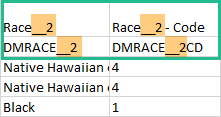
数据筛选 - 数据类型
在数据类型中,您可筛选您想要导出的数据。若您筛选已签名数据,未签名数据,已SDV或无需SDV的数据或需要SDV的数据,有一些数据将出现空白。数据所在的行将由于筛选则在最后一列出现“X”, 并且该列名为:Empty cells on row may be due to export filter。
举例来说,添加受试者的访视中,受试者的生日录入后并被研究者电子签名,然而该数据又做了一次修改,研究者并未再次签名,当您导出数据集时,只选了已签名数据,请看下图:

该受试者的生日的数据点在签名后又被修改(则该空为空白),在最后一列 Empty cells on row may be due to export filter中,您能看到一个“X”:

数据归组
您可选择是否要按照表单对表单归组,通过选择数据归组的下拉菜单。
注意!数据归组的功能只适用于Excel/CSV。
数据按表单归组
当您选择了数据按表单归组,则每张表单都会有相应的excel表。表名为表单ID(在Viedoc Designer中设计)。
图中的例子是默认选项布局:每个活动占一行。
在每张表单相应的excel表中,左侧的前几列都是相同的,提供的都是中心,受试者,访视,活动和设计版本:
| 表格列名 | 描述信息 |
|---|---|
| Site Sequence number | 研究中心的序列号。 |
| Site name | 在Viedoc Admin中设置的中心名称。 |
| Site code | 在Viedoc Admin中设置的中心代码。 |
| Subject sequence number | 受试者在中心的序列号。 |
| Subject Id | 受试者ID,该格式在Viedoc Designer中定义。受试者ID在 Viedoc Clinic中的受试者卡,受试者详情页等会显示。 |
| Event sequence number | 该受试者同一访视重复的次数。 |
| Event Id | 访视ID,在研究设计中设置(Viedoc Designer中)。 |
| Event name | 访视名,在研究设计中设置(Viedoc Designer中)后会显示在Viedoc Clinic。 |
| Event date | 访视日期,在Viedoc Clinic中填写的访视开启日期。 |
| Activity Id | 活动ID,在Viedoc Designer中设定的活动ID。 |
| Activity name | 活动名,在Viedoc Designer中设定的活动名。 |
| Form sequence number |
重复表单序列号,通常该表单设置为可重复。 对于非可重复表单,该列为“1”,如果表单重置后再保存则该列变为“2”,以此类推。 |
| Subject form sequence number | 受试者层面的表单序列号,从“1”开始然后每当该受试者有添加一张新的该表单则数字增加一次。 |
| Origin Subject form sequence number | 对于可复制表单,受试者层面的原表单序列号。对于非复制表单,该数值等于SubjectFormSeqNo。 |
| Source Subject form sequence number | 对于可复制表单,该数值等于源表单被复制次数,与其源复制表单的SubjectFormSeqNo数值相等。对于非复制表单,该空为空。 |
| Design version | 该表单的设计版本。 |
上面图片锁展示的是我们的默认布局,每个活动占一行。
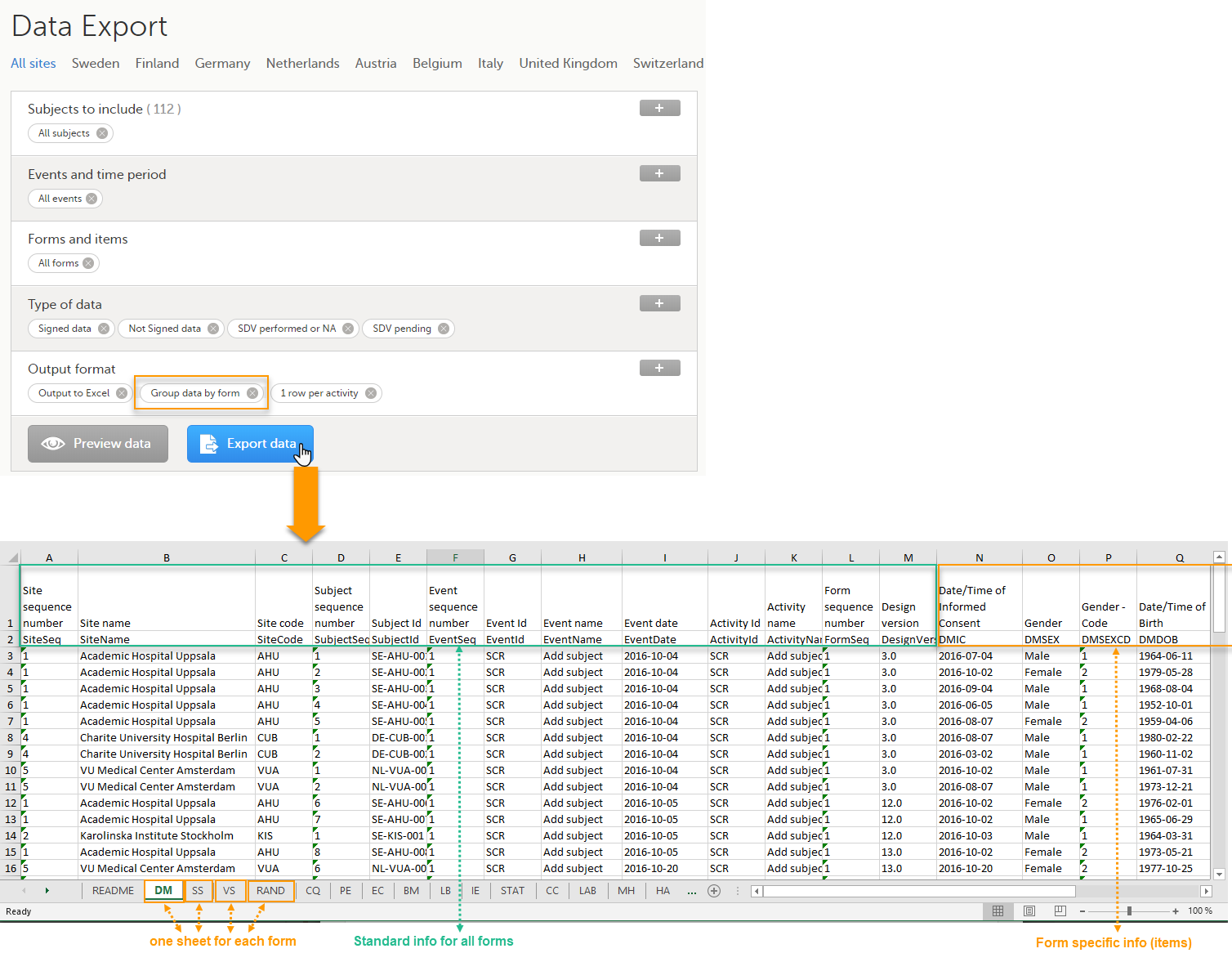
不设数据归组
当您选择不设数据归组时,则所有数据都将在同一张Excel(Data)中。
下图例子为导出的默认布局:每个活动占一行。
在Data表中,左侧的绿色列提供中心,受试者,访视和活动的信息。
下图中右侧的橙色列 是该访视中所有表单的特定信息,对于每张表单,如下列将会记录在其中:
- <表单名>_设计版本 -(在Viedoc Designer中设定的)表单名。图中例子为Demographics。
- <表单名>(<Form Repeat Key>)_<项名> - 对于表单中每项,表单名和项名,都是在研究设计中设定的。对于可重复表单,Form Repeat Key能告诉您这是第几次重复。对于非重复表单,Form Repeat Key总是1。

布局
在布局的部分,您可选择导出数据的布局:

每个受试者占一行
图中例子为布局选择每个受试者占一行(其他设置为默认)。
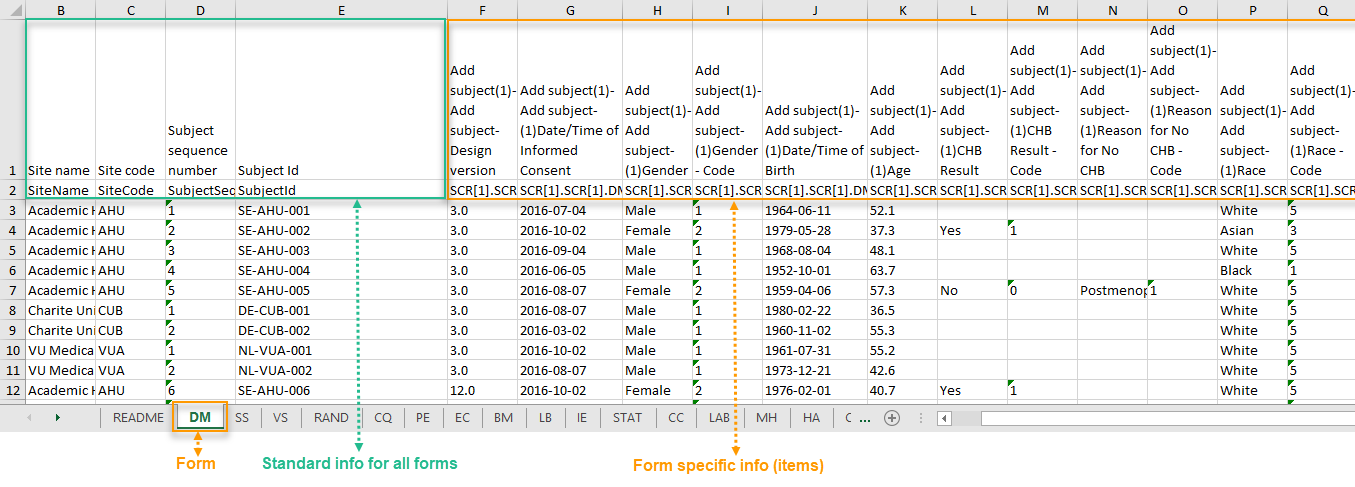
数据归组为默认选项:数据按表单归组。
每个受试者一行,单一受试者ID占一行。
前几列提供中心和受试者的信息:
| 表格列名 | 描述信息 |
|---|---|
| Site name | 在Viedoc Admin中设置的中心名称。 |
| Site code | 在Viedoc Admin中设置的中心代码。 |
| Subject sequence number | 受试者在中心的序列号。 |
| Subject Id | 受试者ID,该格式在Viedoc Designer中定义。受试者ID在 Viedoc Clinic中的受试者卡,受试者详情页等会显示。 |
接下去的列都包括特定的项,项的排列根据访视来排列在试验流程中设定。
- 若您选择了不设数据归组(详见不设数据归组):
<访视名>(<Event Repeat Key>) - <活动名> <表单名> <项名> <代码列表值>:- <访视名> - 在研究设计中设定的访视名。
- <Event Repeat Key> - 访视重复次数,只适用于计划外/普通访视。
- <活动名> - 在研究设计中设定的活动名。
- <表单名> - 在研究设计中设定的表单名。
- <项名> - 在研究设计中设定的项名。
- <代码列表值> - 在研究设计中设定的复选框。
- 当您选择了数据按表单归组(详见数据按表单归组),除了没有 <表单名>这一列,其他与不设数据归组类似。
注意!当您每个受试者占一行时,将不包括Event sequence number, Event Id, Activity Id, Form sequence number, Subject form sequence number, Origin Subject form sequence number和Source Subject form sequence number在导出中 。
每个活动占一行
图中例子为布局选择每个活动占一行(所有设置为默认)。
数据归组为默认选项:数据按表单归组。
数据按每个受试者 (1)每个活动 (2)排列。
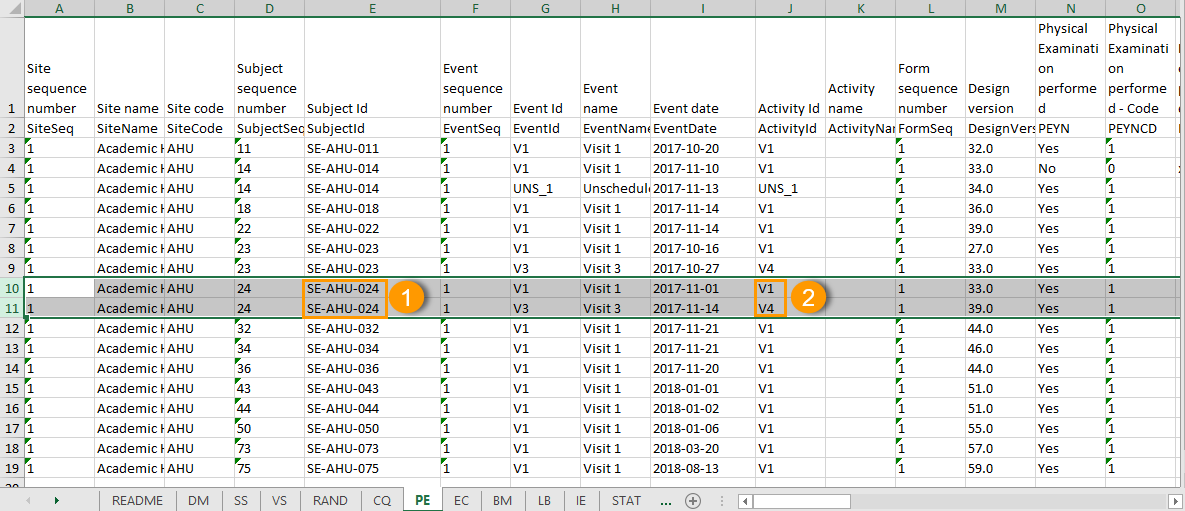
复选框
结构
活动的所有复选框回答都会被导出到同一行中,每个选项编码列表选项分别位于不同的列。分配选项编码列表的项目将输出到选项编码的另一行,ID后缀为“CD”。
输出列
每个选项编码列表选项包括两列:一列用于标签,一列用于选项编码值。列标题使用项目的OID和导出标签,每个后缀都有一个基于1的索引(例如,CHECKBOXOID_LABEL1、CHECKBOXOID_LABEL1CD)。在相应的列中仅填充选定的选项编码列表值。未选择的选项留空。
每个值占一行
图中例子为布局选择每个值占一行(其他设置为默认)。
数据归组为默认选项:数据按表单归组。
数据按每个受试者 (1) 在每个活动中 (2) 的每个字段 (3)排列。
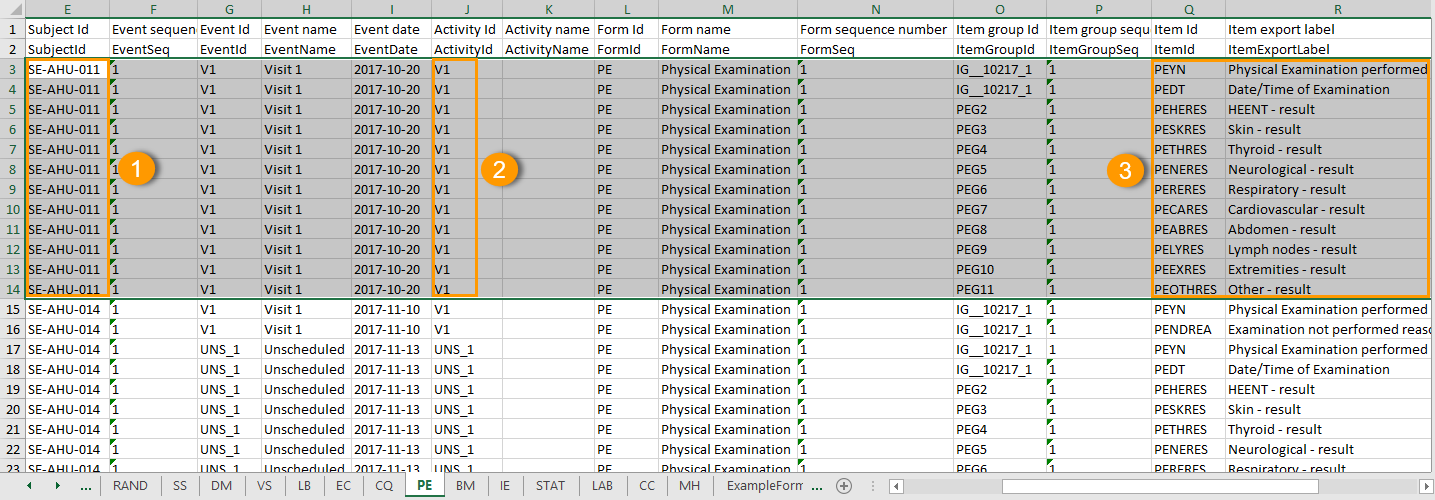
数据按以下排列:中心,受试者,访视日期,访视重复序列,表单重复序列,表单ID,项组ID,项ID。
当您选择包含历史时(见下方介绍),数据将从最久排列到最新(按照 Edit sequence number)。
包含历史
当您选择每个值占一行时,您也可选择包含历史。当您选择此选项时,您可查看到该数据点的稽查轨迹(与在Viedoc Clinic中表单点击显示历史相类似)。
您能在该导出中看到添加的其他列:
- Edit sequence number - 每个值修改的计数。
- Edit reason - 修改的理由(初始数据或再次编辑的理由)。再次编辑的理由如下:
- 初始数据输入
- 功能执行
- 转录错误
- 确认缺失
- 由关联数值改变引起自动更新
- 由关联数据引起删除
- 应用的修订
- 质疑解决
- 表格重置: 转录错误
- 表格重置: 质疑解决
- 导入
- 其他(用户输入的原因)
- Edit by - 修改的用户(用户名和用户ID)。
- Edit date/time (UTC) - 编辑日期/时间(UTC)。
当这些项被重置或表单/访视/受试者被删除后,您也可查看到历史信息以及重置或删除的理由。
复选框选项的每个选项编码会生成两列:一列用于存储选项编码,另一列用于存储对应的选项编码描述。
分配选项编码列表的项目将输出到选项编码的另一行,ID后缀为“CD”。
复选框
复选框项按每个选项编码列表项输出。分配选项编码列表的项目将输出到选项编码的另一行,ID后缀为“CD”
所含内容
无论是否被选中,所有选项编码列表项都会输出。
标签
项目Id(Item Id)列包含项目的对象标识符(OID),并追加一个基于1的索引,如下图所示:

项目导出标签(Item Export Label)列同样包含导出标签,并追加相同的基于1的索引。
输出列
每个选项编码列表项生成两列:一列用于选项编码标签,一列用于选项编码值。如果选择了选项编码列表值,则其相应值将显示在这些列中。否则,留空。
排序
如果选择了“包含历史记录”选项,则按数据录入时间(即编辑序列号)对选项编码列表项目进行排序。
参考范围
当实验室表格使用参考范围时,应包括实验室名称和实验室代码,并增加以下两列:
SCOPE_XXX和SCOPE_XXXCD(其中XXX是数值)
数据导出中的表单链接项
在输出格式中,表单链接项可以被组织成:
- 每项活动一行(默认)
- 每个项一行
- 每个受试者一行
每项活动一行
每项活动一行,就会产生如下图所示的输出示例。导出的文件包含每个链接表单实例的两列,数据列和ID列,(标题标为ID)。
在下面的例子中:
- 每个链接表单实例显示其显示值(如在Clinic中所示)和ID。
- 本例中的药物Paracetamol与不良事件日志中的两个不同日志相链接。
- ID的格式:EventId-EventSeq-ActivtyId-FormId-FormSeq。

在输出中还有两个标题行:
| 标题行,每项活动一行 | |
|---|---|
| 第1行:数据列 | 项的标签,从选定为1的链接开始计数 |
| 第1行:ID列 | 项的标签,从选定为1的链接开始计数, ID。 |
| 第2行:数据列 | 项的ID,从选定为1的链接开始计数 |
| 第2行: ID列 | 项的ID,从选定为1的链接开始计数,ID。 |
每个项一行
选择每个项一行,会产生如下图所示的输出。导出的文件包含两列标题为项目值和项目代码的附加列,每个链接的表单实例有一行。
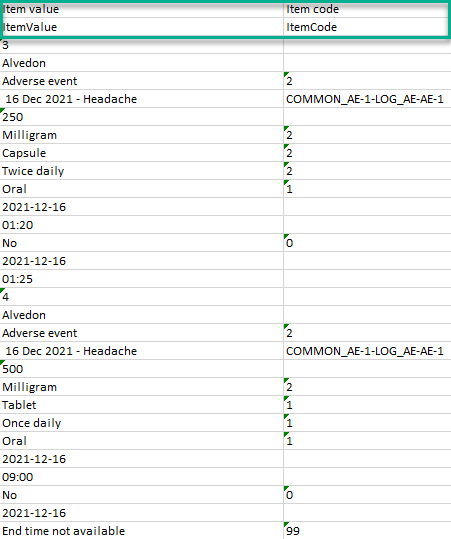
注意! 在导出预览中,表单ID一栏被默认排除。在导出时遵守表单链接项的添加顺序(数据输入时间)。
每个受试者一行
选择每个受试者一行,会产生如下图片所示的输出。导出的文件为每个链接的表单实例添加两列,即数据列和ID列:

在输出中还有两个标题行:
| 标题行,每个受试者一行 | |
|---|---|
| 第1行:数据列 | 访视标签(访视计数),活动标签 (活动计数), 项的标签(所选链接的计数) |
| 第1行:ID列 | 访视标签(访视计数),活动标签 (活动计数), 项的标签(所选链接的计数),ID |
| 第2行:数据列 | 访视 lD(访视计数),活动 lD(活动计数), 项的ID(所选链接的计数) |
| 第2行:ID列 | 访视 lD(访视计数),活动 lD(活动计数), 项的ID(所选链接的计数),ID |
数据导出中的可重复访视
在数据导出出您可以StudyEventRepeatKey区分。
下图的例子为Vital Signs的Excel 导出。该表单在三个访视中出现(Visit 1, Visit 2 and Visit 3)。您在Visit 3中通过查看Event sequence number (EventSeq)列,可看到4个 StudyEventRepeatKey在Event sequence number (EventSeq)列中:

注意! 可重复访视是在4.39版本后发布的。若您想要导出可重复访视,意味着您在选择导出版本的下拉菜单(导出格式中)时,请选择4.39或以后的版本。
数据导出中的可重复表单
在数据导出中您可以FormRepeatKey区分。
下图的例子为Lab的Excel 导出。重复次数FormRepeatKey列在Form sequence number (FormSeq) 列中:

注意! 可重复表单是在4.39版本后发布的。若您想要导出可重复访视,意味着您在选择导出版本的下拉菜单(导出格式中)时,请选择4.39或以后的版本。
可复制表单的数据
Tracking form instances using form sequence numbers
The following form sequence numbers are used to make it easier to track different form instances at subject level, which are useful especially for the form instances initiated by copying the data from previous event.
FormRepeatKey: Counter that identifies the specific instance of a repeating form within a specific activity. This is available in the export output for Viedoc output version 4.39 and onwards.SubjectFormSeqNo: Counter that uniquely identifies the instance of a specific form on a subject level, that is, it starts with 1 and it is incremented each time a new instance of the form is created for that subject. This is available in the export output for Viedoc output version 4.51 and onwards.OriginSubjectFormSeqNo: For a copied form instance, it identifies the form instance from which data was copied for the first time. For the first instance of the form (that is, not copied) it gets the value of theSubjectFormSeqNo. This is available in the export output for Viedoc output version 4.51 and onwards.SourceSubjectFormSeqNo: For a copied form instance, a counter that identifies the source of a copied form instance (the form instance the data was copied from). It gets the value of theSubjectFormSeqNofrom which the form instance was copied. For the first instance of the form (that is, not copied) it is empty, that is, null. This is available in the export output for Viedoc output version 4.51 and onwards.
The example below illustrates how the values for these sequence numbers are assigned. The demo form used is set as repeatable and copyable and is included in Visit 1, Visit 2 and Visit 3.
We perform the following actions in Viedoc Clinic:
| 1 | Initiate Visit 1 and fill in three instances of the Demo form, these instances will get the sequence numbers as illustrated below: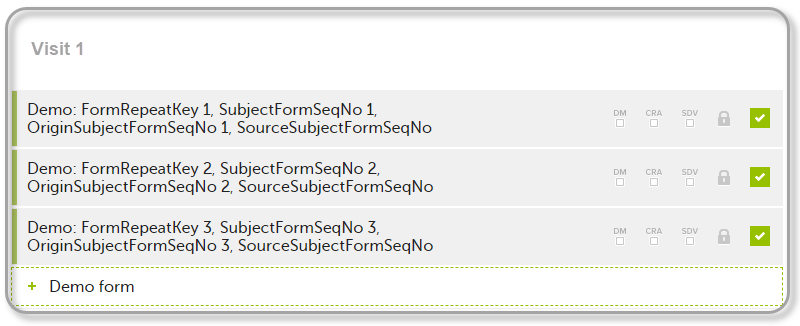 |
| 2 | Initiate Visit 2. Demo form will be available to be initiated by copying data from one of the previously filled-in form instances within Visit 1, so all the three instances will be shown as ghost forms: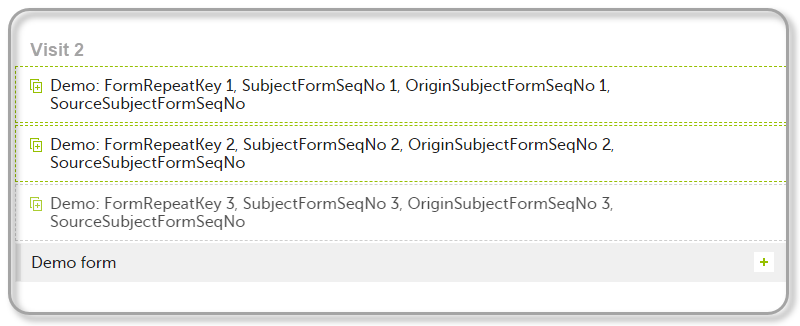 |
| 3 | Create an instance of Demo form within Visit 2 by copying the data from the third instance of the form filled in within Visit 1. This will result in the new form instance getting the sequence numbers as illustrated below: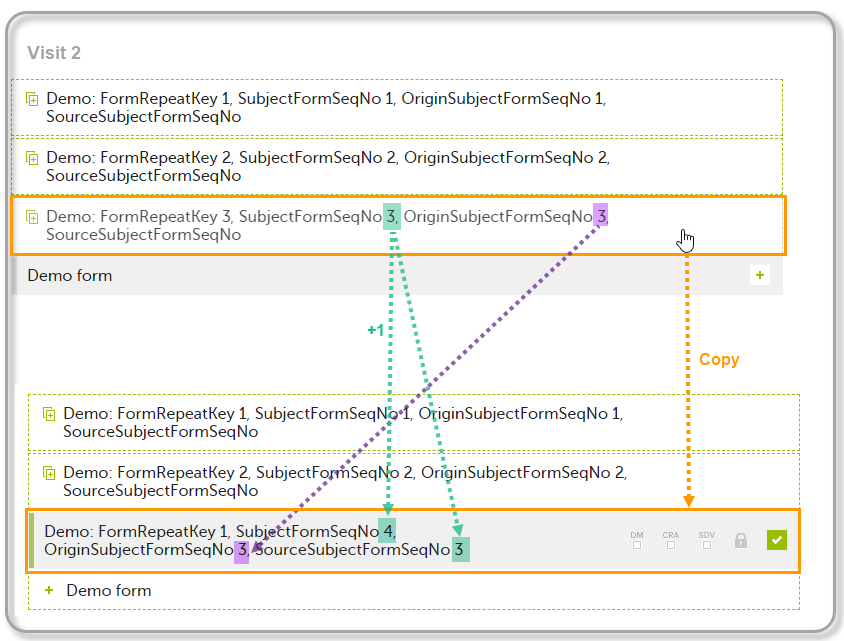 |
| 4 | Initiate Visit 3. Demo form will be available to be initiated by copying data from one of the previously filled-in form instances within Visit 1 and Visit 2, as below: |
| 5 | Create an instance of Demo form within Visit 3 by copying the data from the form filled in within Visit 2. This will result in the new form instance getting the sequence numbers as illustrated below: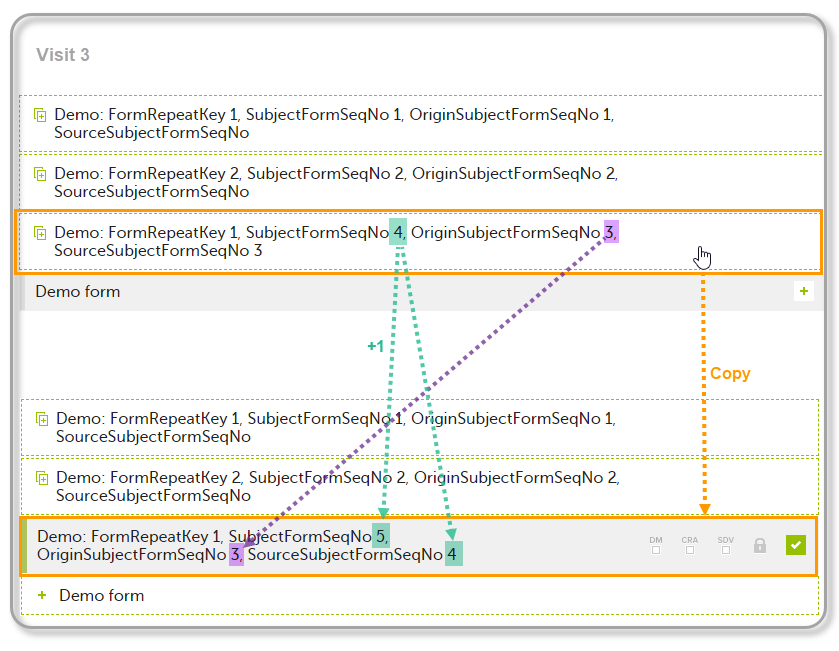 |
These sequence numbers are available to be used within expressions only to get the value of the sequence number for a specific form instance, that is, by using {SubjectFormSeqNo}, {OriginFormSeqNo}, {SourceFormSeqNo}.
In the above example, the form Summary format was configured by using these sequence numbers as below:
Form Repeat Key {FormRepeatKey}, SubjectFormSeqNo {SubjectFormSeqNo}, OriginFormSeqNo {OriginFormSeqNo}, SourceFormSeqNo {SourceFormSeqNo}
Notes!
- Only the FormRepeatKey is used to identify a specific instance of the form in data mapping for data import,as well as in the item identifier used in JavaScript (for example EventID.FormID$ActivityID[FormRepeatKey].ItemID).
- When resetting a form, the sequence numbers are still allocated to it, and the next available ones are used for the new instances.
In the excel export output, these form sequence numbers allows to track, for the form instances that were initiated by copying data from previous events, where the data originates from, as below:
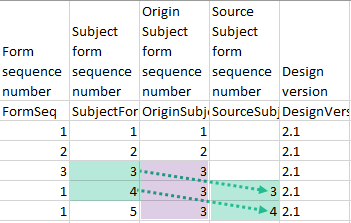
Analyzing the values of the form sequence numbers, only the form instances that were initiated by copying the data from previous visits have values populated in the Source Subject form sequence number column, that is, the last two rows in the example. The data was copied from the form instance having the same Subject form sequence number value, highlighted in green in the above image. The form instance that the data was copied for the first time is identified by the value of the Origin Subject form sequence number, that is, "3" in our example.
